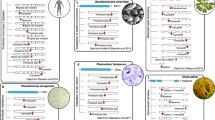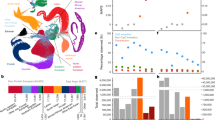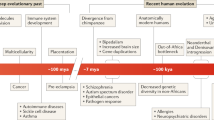Abstract
Human populations have undergone major changes in population size in the past 100,000 years, including recent rapid growth. How these demographic events have affected the burden of deleterious mutations in individuals and the frequencies of disease mutations in populations remains unclear. We use population genetic models to show that recent human demography has probably had little impact on the average burden of deleterious mutations. This prediction is supported by two exome sequence data sets showing that individuals of west African and European ancestry carry very similar burdens of damaging mutations. We further show that for many diseases, rare alleles are unlikely to contribute a large fraction of the heritable variation, and therefore the impact of recent growth is likely to be modest. However, for those diseases that have a direct impact on fitness, strongly deleterious rare mutations probably do have an important role, and recent growth will have increased their impact.
This is a preview of subscription content, access via your institution
Access options
Subscribe to this journal
Receive 12 print issues and online access
$209.00 per year
only $17.42 per issue
Buy this article
- Purchase on Springer Link
- Instant access to full article PDF
Prices may be subject to local taxes which are calculated during checkout




Similar content being viewed by others
References
Coventry, A. et al. Deep resequencing reveals excess rare recent variants consistent with explosive population growth. Nat. Commun. 1, 131 (2010).
Marth, G.T. et al. The functional spectrum of low-frequency coding variation. Genome Biol. 12, R84 (2011).
Keinan, A. & Clark, A.G. Recent explosive human population growth has resulted in an excess of rare genetic variants. Science 336, 740–743 (2012).
Nelson, M.R. et al. An abundance of rare functional variants in 202 drug target genes sequenced in 14,002 people. Science 337, 100–104 (2012).
Tennessen, J.A. et al. Evolution and functional impact of rare coding variation from deep sequencing of human exomes. Science 337, 64–69 (2012).
Fu, W. et al. Analysis of 6,515 exomes reveals the recent origin of most human protein-coding variants. Nature 493, 216–220 (2013).
Keinan, A., Mullikin, J.C., Patterson, N. & Reich, D. Measurement of the human allele frequency spectrum demonstrates greater genetic drift in East Asians than in Europeans. Nat. Genet. 39, 1251–1255 (2007).
Wall, J.D. & Przeworski, M. When did the human population size start increasing? Genetics 155, 1865–1874 (2000).
Voight, B.F. et al. Interrogating multiple aspects of variation in a full resequencing data set to infer human population size changes. Proc. Natl. Acad. Sci. USA 102, 18508–18513 (2005).
Gutenkunst, R.N., Hernandez, R.D., Williamson, S.H. & Bustamante, C.D. Inferring the joint demographic history of multiple populations from multidimensional SNP frequency data. PLoS Genet. 5, e1000695 (2009).
Lohmueller, K.E. et al. Proportionally more deleterious genetic variation in European than in African populations. Nature 451, 994–997 (2008).
Casals, F. & Bertranpetit, J. Human genetic variation, shared and private. Science 337, 39–40 (2012).
Pritchard, J.K. Are rare variants responsible for susceptibility to complex diseases? Am. J. Hum. Genet. 69, 124–137 (2001).
Eyre-Walker, A. Genetic architecture of a complex trait and its implications for fitness and genome-wide association studies. Proc. Natl. Acad. Sci. USA 107, 1752–1756 (2010).
Gibson, G. Rare and common variants: twenty arguments. Nat. Rev. Genet. 13, 135–145 (2011).
Manolio, T.A. et al. Finding the missing heritability of complex diseases. Nature 461, 747–753 (2009).
Schaffner, S.F. et al. Calibrating a coalescent simulation of human genome sequence variation. Genome Res. 15, 1576–1583 (2005).
Hartl, D.L. A Primer of Population Genetics (Sinauer Associates, Inc., 2000).
Travis, J.M. et al. Deleterious mutations can surf to high densities on the wave front of an expanding population. Mol. Biol. Evol. 24, 2334–2343 (2007).
Lynch, M., Conery, J. & Burger, R. Mutational meltdowns in sexual populations. Evolution 49, 1067–1080 (1995).
The 1000 Genomes Project Consortium. A map of human genome variation from population-scale sequencing. Nature 467, 1061–1073 (2010).
Adzhubei, I.A. et al. A method and server for predicting damaging missense mutations. Nat. Methods 7, 248–249 (2010).
Thornton, K.R., Foran, A.J. & Long, A.D. Properties and modeling of GWAS when complex disease risk is due to non-complementing, deleterious mutations in genes of large effect. PLoS Genet. 9, e1003258 (2013).
Johnson, T. & Barton, N. Theoretical models of selection and mutation on quantitative traits. Phil. Trans. R. Soc. Lond. B 360, 1411–1425 (2005).
Charlesworth, B. & Charlesworth, D. Elements of Evolutionary Genetics (Roberts and Company Publishers, 2010).
McVicker, G., Gordon, D., Davis, C. & Green, P. Widespread genomic signatures of natural selection in hominid evolution. PLoS Genet. 5, e1000471 (2009).
Wang, K., Li, M. & Hakonarson, H. ANNOVAR: functional annotation of genetic variants from high-throughput sequencing data. Nucleic Acids Res. 38, e164 (2010).
Kumar, P., Henikoff, S. & Ng, P.C. Predicting the effects of coding non-synonymous variants on protein function using the SIFT algorithm. Nat. Protoc. 4, 1073–1081 (2009).
Chun, S. & Fay, J.C. Identification of deleterious mutations within three human genomes. Genome Res. 19, 1553–1561 (2009).
Schwarz, J.M., Rödelsperger, C., Schuelke, M. & Seelow, D. MutationTaster evaluates disease-causing potential of sequence alterations. Nat. Methods 7, 575–576 (2010).
Acknowledgements
This work was supported by grants from the US National Institutes of Health (NIH) (MH084703 to J.K.P. and GM083228 to G.S.), the Israel Science Foundation (grant 1492/10 to G.S.) and the Howard Hughes Medical Institute (J.K.P.). M.C.T. was supported in part by NIH grant T32 GM007197. We thank D. Reich and S. Sunyaev for helpful discussions and generous input regarding the interpretation of PolyPhen-2, I. Adzhubey for human-independent PolyPhen scores, J. Akey for assistance in accessing data, J. Akey, A. Siepel, G. Coop, I. Eshel, R. Hudson and two anonymous reviewers for comments on the manuscript and M. Przeworski for many discussions and comments on the manuscript.
Author information
Authors and Affiliations
Contributions
J.K.P. and G.S. conceived and supervised the research. Y.B.S., G.S. and J.K.P. developed theory. Y.B.S. performed simulations. M.C.T. and J.K.P. performed data analysis. J.K.P. and G.S. wrote the manuscript with input from Y.B.S. and M.C.T.
Corresponding authors
Ethics declarations
Competing interests
The authors declare no competing financial interests.
Supplementary information
Supplementary Text and Figures
Supplementary Tables 1–5, Supplementary Figures 1–20 and Supplementary Note (PDF 5348 kb)
Rights and permissions
About this article
Cite this article
Simons, Y., Turchin, M., Pritchard, J. et al. The deleterious mutation load is insensitive to recent population history. Nat Genet 46, 220–224 (2014). https://doi.org/10.1038/ng.2896
Received:
Accepted:
Published:
Issue Date:
DOI: https://doi.org/10.1038/ng.2896
This article is cited by
-
Characterization of genome-wide STR variation in 6487 human genomes
Nature Communications (2023)
-
The genomic footprint of whaling and isolation in fin whale populations
Nature Communications (2023)
-
Mexican Biobank advances population and medical genomics of diverse ancestries
Nature (2023)
-
Comparative evolutionary genetics of deleterious load in sorghum and maize
Nature Plants (2021)
-
African genetic diversity and adaptation inform a precision medicine agenda
Nature Reviews Genetics (2021)



